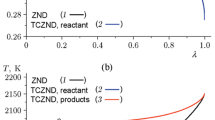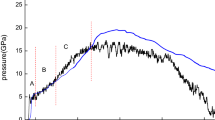Abstract
An improved diffuse interface model is proposed to numerically simulate the interaction dynamics between solid explosive detonation and compressible inert materials. The chemical reaction of solid explosive detonation is simplified as the solid-phase reactant is converted into a gas-phase product. Thus, the mixture within a control volume is regarded to be composed of three kinds of components: solid-phase reactant, gas-phase product, and inert materials. Due to their differences in thermodynamic properties, three kinds of components can be thought to be in mechanical equilibrium and thermal nonequilibrium. The evolution equation for the volume fractions of all components is derived on the basis of the entropy production and pressure equality among the components. The evolution equation for the pressure of the mixture is also obtained and added to the diffuse interface model. Thus, the governing equations of the proposed diffuse interface model include the conservation equations for the mass of each component, the conservation equations for the momentum and total energy of the mixture, the evolution equation for the volume fraction of each component, and the evolution equation for the pressure of the mixture. The important characteristics of the proposed model are simultaneous consideration of mass transfer from the chemical reaction and heat exchange from thermal nonequilibrium and also direct calculation of the pressure from the governing equations. The proposed model owns thermodynamic consistency to effectively eliminate nonphysical oscillations near the material interface. Meanwhile, it can apply to arbitrary expressions of the equation of state, allow for any number of inert materials, and also treat large density ratios across the material interface.








Similar content being viewed by others
REFERENCES
W. Fickett and W. C. Davis, Detonation: Theory and Experiment (Dover, New York, 1979).
J. von Neumann and R. D. Richtmyer, “A Method for the Numerical Calculations of Hydrodynamical Shocks," J. Appl. Phys. 21 (3), 232–238 (1950); DOI: 10.1063/1.1699639.
M. L. Wilkins, “Calculation of Elastic–Plastic Flow," in Methods in Computational Physics (Academic Press, New York, 1964), Vol. 3.
D. J. Benson, “Computational Methods in Lagrangian and Eulerian Hydrocodes," Comput. Meth. Appl. Mech. Eng. 99 (2/3), 235–394 (1992); DOI: 10.1016/0045-7825(92)90042-I.
D. J. Benson, “A Multi-Material Eulerian Formulation for the Efficient Solution of Impact and Penetration Problems," Comput. Mech. 5 (6), 558–571 (1995); DOI: 10.1007/BF00350268.
J. Glimm, E. Isaacson, D. Marchesin, and O. McBryan, “Front Tracking for Hyperbolic Systems," Adv. Appl. Math. 2 (1), 91–119 (1981); DOI: 10.1016/0196-8858(81)90040-3.
G. Tryggvason, B. Bunner, A. Esmaeeli, et al. “A Front-Tracking Method for the Computations of Multiphase Flow," J. Comput. Phys. 169 (2), 708–759 (2001); DOI: 10.1006/jcph.2001.6726.
C. Hirt and B. Nichols, “Volume of Fluid (VOF) Method for the Dynamics of Free Boundaries," J. Comput. Phys. 39 (1), 201–225 (1981); DOI: 10.1016/0021-9991(81)90145-5.
R. Saurel and R. Abgrall, “A Multiphase Godunov Method for Compressible Multifluid and Multiphase Flows," J. Comput. Phys. 150 (2), 425–467 (1999); DOI: 10.1006/jcph.1999.6187.
M. Sussman, P. Smereka, and S. Osher, “A Level Set Approach for Computing Solutions to Incompressible Two-Phase Flow," J. Comput. Phys. 114 (1), 146–159 (1994); DOI: 10.1006/jcph.1994.1155.
T. D. Aslam, J. B. Bdzil, and D. S. Stewart, “Level Set Method Applied to Modeling Detonation Shock Dynamics," Mech. Sci. Eng. 126 (2), 390–409 (1996); DOI: 10.1006/jcph.1996.0145.
N. T. Nguyen, “Numerical Methods for Compressible Multi-Phase Flows with Surface Tension," Ph.D. Thesis, University of Trento (April 2017).
L. Michael and N. Nikiforakis, “A Hybrid Formulation for the Numerical Simulation of Condensed Phase Explosives," J. Comput. Phys. 316, 193–217 (2016); DOI: 10.1016/j.jcp.2016.04.017.
S. Karni, “Multicomponent Flow Calculations by a Consistent Primitive Algorithm," J. Comput. Phys. 112 (1), 31–43 (1994); DOI: 10.1006/jcph.1994.1080.
V. T. Ton, “Improved Shock-Capturing Methods for Multicomponent and Reacting Flows," J. Comput. Phys. 128 (1), 237–253 (1996); DOI: 10.1006/jcph.1996.0206.
K. Shyue, “An Efficient Shock-Capturing Algorithm for Compressible Multicomponent Problems," J. Comput. Phys. 142 (1), 208–242 (1998); DOI: 10.1006/jcph.1998.5930.
S.-P. Wang, M. H. Anderson, J. Oakley, et al., “A Thermodynamically Consistent and Fully Conservative Treatment of Contact Discontinuities for Compressible Multicomponent Flows," J. Comput. Phys. 195 (2), 528–559 (2004); DOI: 10.1016/j.jcp.2003.10.010.
J. W. Banks, D. W. Schwendeman, A. K. Kapila, and W. D. Henshaw, “A High-Resolution Godunov Method for Compressible Multi-Material Flow on Overlapping Grids," J. Comput. Phys. 223 (1), 262–297 (2007); DOI: 10.1016/j.jcp.2006.09.014.
B. J. Lee, E. F. Toro, C. E. Castro, and N. Nikiforakis, “Adaptive Osher-Type Scheme for the Euler Equations with Highly Nonlinear Equations of State," J. Comput. Phys. 246, 165–183 (2013); DOI: 10.1016/j.jcp.2013.03.046.
M. R. Baer and J. W. Nunziato, “A Two-Phase Mixture Theory for the Deflagration-to-Detonation Transition (DDT) in Reactive Granular Materials," Int. J. Multiphase Flow 12 (6), 861–889 (1986); DOI: 10.1016/0301-9322(86)90033-9.
A. K. Kapila, R. Menikoff, J. B. Bdzil, and S. F. Son, “Two-Phase Modeling of Deflagration-to-Detonation Transition in Granular Materials: Reduced Equations," Phys. Fluids 13 (10), 3002–3024 (2001); DOI: 10.1063/1.1398042.
R. Saurel, F. Petitpas, and R. A. Berry, “Simple and Efficient Relaxation Methods for Interfaces Separating Compressible Fluids, Cavitating Flows and Shocks in Multiphase Mixtures," J. Comput. Phys. 228 (5), 1678–1712 (2009); DOI: 10.1016/j.jcp.2008.11.002.
R. Saurel and C. Pantano, “Diffuse-Interface Capturing Methods for Compressible Two-Phase Flows," Annu. Rev. Fluid Mech. 50, 105–130 (2018); DOI: 10.1146/annurev-fluid-122316-050109.
M. R. Baer and M. E. Kipp, “Micromechanical Modeling of Heterogeneous Energetic Materials," in Proc. of the 11th Int. Detonation Symp., Snowmass, 1998, pp. 788–797.
C. A. Handley, B. D. Lambourn, N. J. Whitworth, et al., “Understanding the Shock and Detonation Response of High Explosives at the Continuum and Meso Scales," Appl. Phys. Rev. 5, 011303 (2018); DOI: 10.1063/1.5005997.
F. Zhang, Shock Wave Science and Technology Reference Library. Detonation Dynamics (Springer-Verlag, Berlin–Heidelberg, 2012), Vol. 6.
F. Findik, “Recent Developments in Explosive Welding," Mater. Des. 32 (3), 1081–1093 (2011); DOI: 10.1016/j.matdes.2010.10.017.
J. W. Grove, “Some Comments on Thermodynamic Consistency for Equilibrium Mixture Equations of State," Comput. Math. Appl. 78 (2), 582–597 (2019); DOI: 10.1016/j.camwa.2018.03.012.
E. F. Toro, Riemann Solvers and Numerical Methods for Fluid Dynamics (Springer-Verlag, Berlin–Heidelberg, 1999).
X.-L. Zhong, “Additive Semi-Implicit Runge–Kutta Methods for Computing High-Speed Nonequilibrium Reactive Flows," J. Comput. Phys. 128 (1), 19–31 (1996); DOI: 10.1006/jcph.1996.0193.
J. Castor, Radiation Hydrodynamics (Cambridge Univ. Press, 2004).
R. J. LeVeque, Finite Volume Methods for Hyperbolic Problems (Cambridge Univ. Press, 2004).
C. M. Tarver and E. M. McGuire, “Reactive Flow Modeling of the Interaction of TATB Detonation Waves with Inert Materials," in The 12th Symp. (Int.) on Detonation, San Diego, 2002, pp. 641–649.
S. P. Marsh, LASL Shock Hugoniot Data (Univ. of California Press, Berkeley, 1980).
K.-M. Shyue, “A Fluid-Mixture Type Algorithm for Compressible Multicomponent Flow with Mie–Grüneisen Equation of State," J. Comput. Phys. 171 (2), 678–707 (2001); DOI: 10.1006/jcph.2001.6801.
R. L. Gustavsen, S. A. Sheffield, and R. R. Alcon, “Measurements of Shock Initiation in the Tri-Amino-Tri-Nitro-Benzene Based Explosive PBX 9502: Wave Forms from Embedded Gauges and Comparison of Four Different Material Lots," J. Appl. Phys. 99 (11), 114907 (2006); DOI: 10.1063/1.2195191.
M. Short and J. J. Quirk, “High Explosive Detonation–Confiner Interactions," Annu. Rev. Fluid Mech. 50, 215–242 (2018); DOI: 10.1146/annurev-fluid-122316-045011.
S. Schoch, N. Nikiforakis, and B. J. Lee, “The Propagation of Detonation Waves in Non-Ideal Condensed-Phase Explosives Confined by High Sound-Speed Materials," Phys. Fluids 25 (8), 086102 (2013); DOI: 10.1063/1.4817069.
S. Schoch, K. Nordin-Bates, and N. Nikiforakis, “A Eulerian Algorithm for Coupled Simulation of Elastoplastic–Solids and Condensed-Phase Explosives," J. Comput. Phys. 252 (9), 163–194 (2013); DOI: 10.1016/j.jcp.2013.06.020.
Author information
Authors and Affiliations
Corresponding author
Additional information
Translated from Fizika Goreniya i Vzryva, 2022, Vol. 58, No. 1, pp. 86-103.https://doi.org/10.15372/FGV20220109.
Rights and permissions
About this article
Cite this article
Yu, M., Ma, ZB. Thermodynamically Consistent Diffuse Interface Model for the Numerical Simulation of Interaction between Solid Explosive Detonation and Inert Materials. Combust Explos Shock Waves 58, 77–92 (2022). https://doi.org/10.1134/S0010508222010099
Received:
Revised:
Accepted:
Published:
Issue Date:
DOI: https://doi.org/10.1134/S0010508222010099




